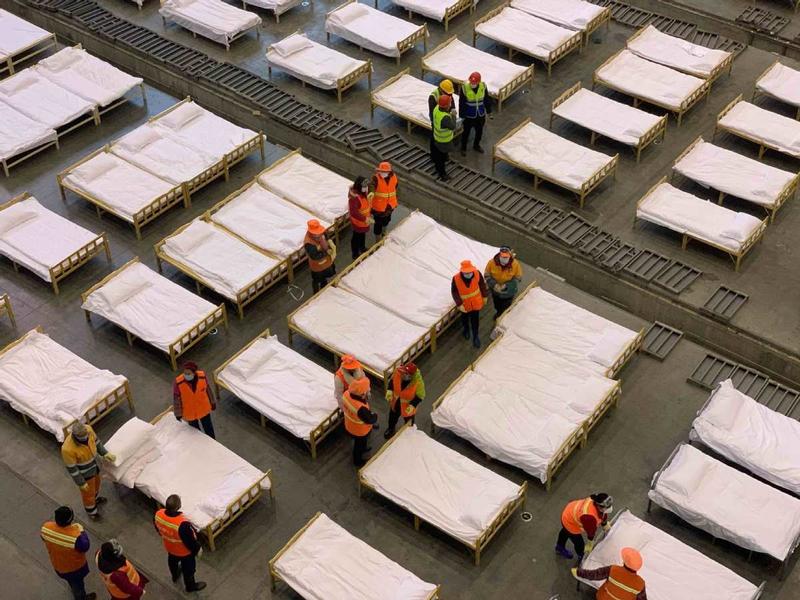 The Wuhan Parlor convention center is renovated into a cabin hospital in Wuhan, capital of Central China's Hubei province, on Feb 4, 2020. (YUAN ZHENG / FOR CHINADAILY.COM.CN)
The Wuhan Parlor convention center is renovated into a cabin hospital in Wuhan, capital of Central China's Hubei province, on Feb 4, 2020. (YUAN ZHENG / FOR CHINADAILY.COM.CN)
The mortality rate for known cases of the novel coronavirus is significantly higher in Wuhan, Hubei province, the epicenter of the outbreak, than other parts of the country — a gap that health officials and experts are racing to close by ramping up medical assistance and enhancing the region's critical care capability.
The mortality rate — total deaths as a proportion of the number of confirmed cases — is running at 2.1 percent on the Chinese mainland, down from 2.3 percent at the onset of the outbreak, the National Health Commission said on Tuesday.
A dire shortage of intensive care specialists and hospital beds has contributed to the higher mortality rate in Wuhan, according to an official of the National Health Commission
READ MORE: Death rate from coronavirus pneumonia dropping
In Hubei province, the death rate of confirmed infections averages at 3.1 percent, while in Wuhan, the provincial capital, where the disease first surfaced, the mortality rate is estimated to be around 4.9 percent, according to the commission.
After excluding infections and fatalities reported in Hubei, the death rate in 30 other provincial-level regions on the mainland dropped to 0.16 percent, according to Jiao Yahui, deputy chief of the commission's medical administration and supervision department.
A dire shortage of intensive care specialists and hospital beds has contributed to the higher mortality rate in Wuhan, Jiao said.
"The three hospitals designated to receive infected patients in severe condition house a total of 110 beds in their intensive care units, which far from meets the demand," she said.
"The remaining seriously ill patients are then allocated to about 20 medical institutions across the city, which may not be able to provide sufficient professional care from intensive care staff," Jiao said. "This has also weakened the city's capability to save critically ill patients."
ALSO READ: Key meeting emphasizes treating all patients
To address the shortage, the commission has recently assigned three other hospitals in Wuhan to focus on treating severe cases of the new virus. They are designed to accommodate a total of 1,000 patients requiring special care.
About 3,000 doctors and nurses specializing in providing intensive care will be deployed to take charge of wards receiving patients in a serious condition, the commission said.
"A new team composed of the presidents or leading Party officials of 16 hospitals across the country has also gathered and is on standby. It is intended to improve the management of intensive care units in Wuhan and drive down the mortality rate in the city," Jiao said.
To address the shortage, the National Health Commission has recently assigned three other hospitals in Wuhan to focus on treating severe cases of the new virus
ALSO READ: Pandemic puts governance capabilities to test
Li Lanjuan, a member of the commission's senior-level expert panel, said in an interview with China Central Television on Monday night that the outbreak is nearing its peak.
The rising caseload is straining the already overburdened medical institutions in Hubei, leading to a lack of medical staff capable of concentrating on the critically ill, Li said.
"In Hubei, and particularly in Wuhan, one doctor could be under great pressure to monitor several patients, while in other regions, a handful of doctors are able to focus on one patient," she said.
Official figures released on Tuesday morning show that the number of confirmed cases in Hubei province rose by 2,345 on Monday, including 1,242 new cases in Wuhan, to 13,522. The death toll in the region went up by 64 to 414 on Monday.
"However, with the medical assistance and advanced therapies destined for Wuhan, it is very likely that the disease will be contained and the death rate will be cut," Li added.
Though much remains unknown about the novel coronavirus, medical experts largely agree that it is not as lethal as other pathogens from the same family.
READ MORE: WHO says coronavirus outbreak not yet pandemic
In contrast, severe acute respiratory syndrome killed about 9.6 percent of those who contracted the virus, and the Middle East respiratory syndrome, which still sees isolated cases cropping up, now kills about one-in-three, according to the World Health Organization.
Foreign Ministry spokeswoman Hua Chunying said during an online daily news conference on Tuesday that the mortality rate of the novel coronavirus infections in China is far lower than that of the H1N1 flu outbreak in the United States in 2009, MERS and Ebola.
She reiterated China's opposition to unreasonably strong reactions to the epidemic, but said a global effort is needed to overcome the epidemic.
According to Jiao, from the National Health Commission, 80 percent of the deaths during the novel coronavirus outbreak have occurred among those age 60 and over, and 75 percent of the dead suffered from existing medical conditions.
Most cases are not critical, she said. "There is no need to panic."
Li Xinwang, head of Beijing Ditan Hospital's center for infectious diseases, said as research into effective antiviral drugs is underway, consistent life support and respiratory assistance are crucial for patients during treatment.
Zhou Lihua and Liu Kun in Wuhan, and Wang Qingyun in Beijing contributed to this story.
Contact the writers at wangxiaoyu@chinadaily.com.cn


